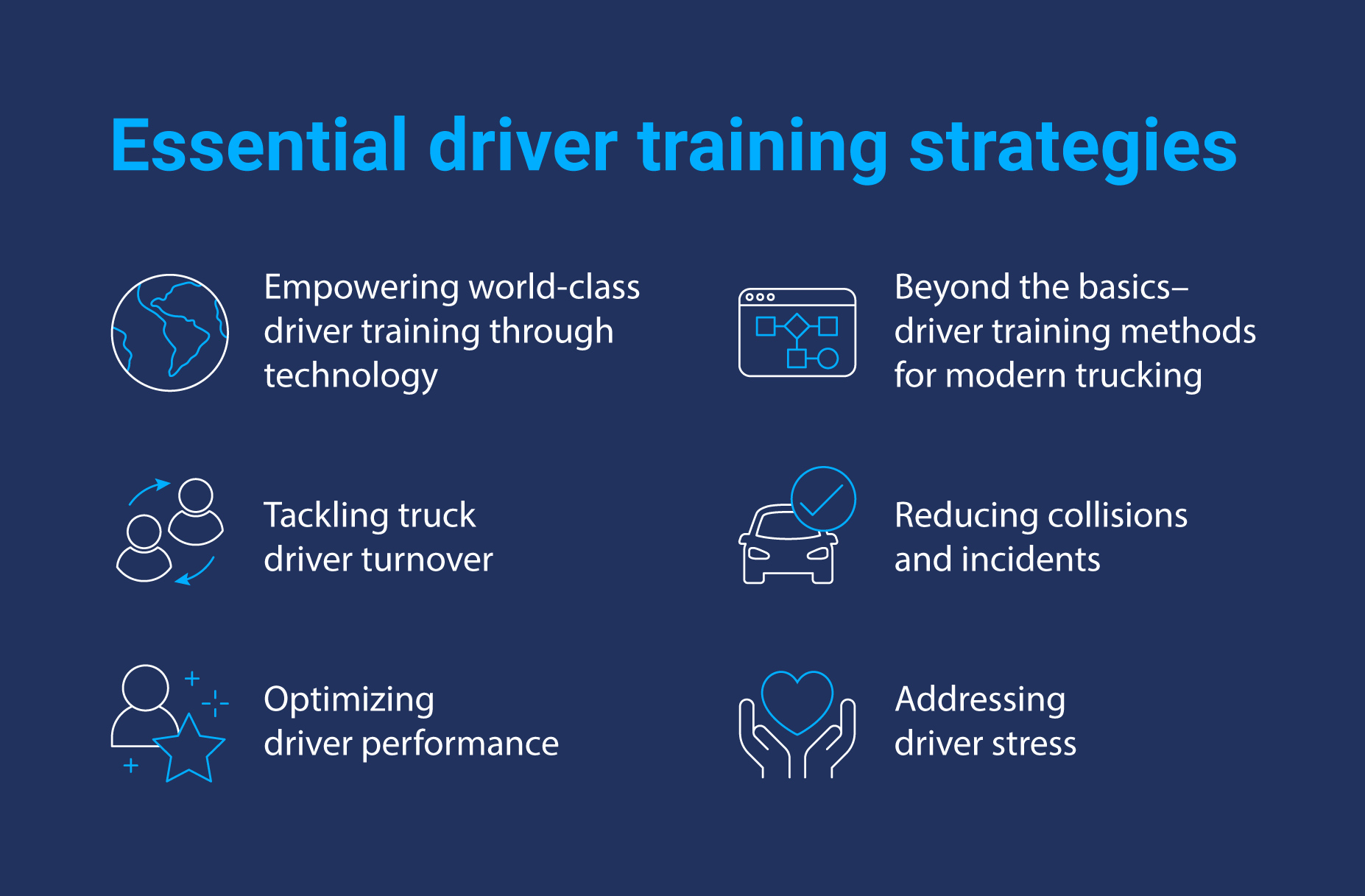Building a world-class driver training program: Essential strategies for truckload carriers
What's the true cost of inadequate driver training? The answer: more collisions, skyrocketing costs and a revolving door of drivers. The good news? There's a solution.


Key Insights
- Prioritize comprehensive training: Go beyond basic compliance to focus on advanced techniques, continuous learning, and specialized skills like defensive driving and fuel efficiency.
- Leverage technology for optimization: Utilize telematics solutions like Geotab to monitor driver behavior, provide real-time coaching, automate tasks, and gain data-driven insights for improved performance.
- Focus on safety and retention: Implement proactive safety training to reduce collisions and create a positive driver experience that boosts satisfaction and reduces costly turnover.
The truckload carrier industry operates in a high-stakes environment. Every mile driven carries the potential for risk, and the consequences of inadequate driver training can be severe. From increased collisions and soaring insurance premiums to legal liabilities and reputational damage, the costs are simply too high to ignore. Add to that the challenge of driver turnover, and it's clear that world-class driver training isn't just a nice-to-have – it's a business imperative. This blog post will explore essential strategies for truckload carriers looking to build and implement effective driver training programs that improve safety, boost retention, and optimize overall performance.
The high stakes of truckload carrier safety
Safety is paramount in the truckload carrier industry. The sheer size and weight of commercial vehicles, combined with the long distances and challenging conditions drivers often face, create inherent risks. Inadequate driver training amplifies these risks, leading to a cascade of negative consequences. Collisions not only endanger lives but also result in costly repairs, downtime and potential legal battles. Insurance premiums for trucking fleets rose by an average of 12.5% in 2023, driven by factors such as nuclear verdicts, increased litigation and higher accident rates. A single high-profile incident can tarnish a company's reputation, impacting customer trust and business opportunities. Investing in comprehensive driver training is not just a matter of compliance – it's a fundamental strategy for mitigating risk and protecting the bottom line.

Tackling truck driver turnover
The average annualized turnover from 1996 to 2023 was 92.7% for large truckload carriers and 77.6% for smaller carriers. This constant churn creates significant costs associated with recruiting, hiring and onboarding new drivers. Effective driver training programs play a crucial role in improving driver satisfaction and increasing retention. When drivers feel well-prepared, supported and valued, they are more likely to stay with a company long-term. Robust training demonstrates an investment in the driver's success, fostering a sense of loyalty and reducing the costly cycle of turnover.
Beyond the basics – driver training methods for modern trucking
Gone are the days when basic training was sufficient for truck drivers – the modern trucking industry demands a more sophisticated approach. Effective driver training methods must go beyond simply teaching the rules of the road. Continuous learning is essential, with ongoing training to reinforce skills, introduce new technologies and address emerging challenges. Incorporating technology into training, such as simulators and online modules, can enhance engagement and knowledge retention. Training programs should also focus on specialized skills, such as defensive driving techniques to avoid collisions, fuel-efficient driving practices to reduce costs and proper load securement to ensure safety and prevent damage.
Optimizing driver performance
Improving truck driver performance is an ongoing process that requires a structured approach. A step-by-step guide to continuous improvement should include setting clear performance goals for drivers, providing regular feedback on their progress and using data to track performance metrics over time. This data-driven approach allows carriers to identify areas where drivers excel and areas where they need additional support. By focusing on continuous improvement, carriers can enhance safety, increase efficiency and maximize productivity.
Reducing collisions and incidents
Preventing collisions and incidents requires a proactive approach to driver training. Training programs should emphasize risk assessment, teaching drivers how to identify and anticipate potential hazards on the road. Predictive analytics can be used to analyze data and identify high-risk drivers or routes, allowing carriers to provide targeted training interventions. Incorporating safety technology, such as advanced driver-assistance systems (ADAS), into training programs is also crucial, ensuring that drivers are proficient in using these tools to enhance safety.
Addressing driver stress
Driver stress is a growing crisis in the trucking industry, affecting safety, retention and overall job performance. Long hours, tight deadlines and increasing pressure are pushing many drivers to the brink, with 68% reporting that stress is negatively impacting their ability to drive. This pressure leads to riskier behaviors, including speeding and fatigue-related mistakes, which contribute to rising collision rates. However, fleets that prioritize driver well-being through better scheduling, real-time navigation tools and advanced safety technology see improved retention, safer roads and stronger performance. Investing in comprehensive driver training programs that incorporate these tools can help reduce stress, prevent burnout and create a safer, more sustainable industry for the long haul.
Geotab: Empowering world-class driver training through technology
Geotab is committed to providing the technology and tools that empower truckload carriers to build world-class driver training programs. Our telematics solutions offer a wealth of data and insights that can be used to enhance training effectiveness, improve driver performance and create a safer operating environment. By leveraging Geotab's technology, carriers can move beyond traditional training methods and embrace a more data-driven, personalized and effective approach.
How Geotab’s telematics solutions improve driver training
Geotab's telematics solutions offer powerful tools to address the key challenges faced by truckload carriers and revolutionize driver training:
- Improving Safety: Geotab helps resolve safety concerns by providing tools for comprehensive driver behavior monitoring. This allows carriers to track metrics such as harsh braking, speeding and aggressive driving, identifying areas where drivers need additional coaching. In-vehicle coaching solutions provide real-time feedback to drivers, helping them correct unsafe behaviors on the road. Furthermore, Geotab's technology aids in collision reconstruction, providing valuable data to analyze incidents and prevent future occurrences.
- Boosting Retention: Geotab contributes to improved driver retention by offering solutions that streamline administrative tasks and enhance the driver experience. Geotab Drive automates many of the tedious tasks that drivers face, freeing up their time and reducing stress. Geotab also provides tools for driver feedback and engagement, including our Vitality program that rewards drivers based on good driving habits, fostering a sense of connection and value. Gamification can also be a powerful tool to motivate drivers and make training more engaging.
- Optimizing Performance: Geotab facilitates continuous improvement in driver performance through a range of features. Driver scorecards provide a clear and objective assessment of driver behavior, allowing for targeted coaching and development. Geotab's data-driven insights provide valuable information on driver performance trends, enabling carriers to identify best practices and areas for improvement. Our driver coaching solutions offer the tools you need to build a top-tier training program.
Conclusion
A world-class driver training program is no longer a luxury for truckload carriers – it's a necessity for ensuring safety, improving driver retention and optimizing overall operations. By prioritizing effective training methods and leveraging technology to enhance training delivery and effectiveness, carriers can create a safer, more efficient and more sustainable future. Geotab's telematics solutions provide the tools and insights needed to build and implement such programs, empowering truckload carriers to achieve their training goals and drive success.
To learn more about how Geotab can help your truckload fleet, click here.
Subscribe to get industry tips and insights

Christine is the Content Manager for the Geotab Marketplace.
Table of Contents
- The high stakes of truckload carrier safety
- Tackling truck driver turnover
- Beyond the basics – driver training methods for modern trucking
- Optimizing driver performance
- Reducing collisions and incidents
- Addressing driver stress
- Geotab: Empowering world-class driver training through technology
- How Geotab’s telematics solutions improve driver training
- Conclusion
Subscribe to get industry tips and insights
Related posts

Marketplace Spotlight: From Chaos to Clarity, Innovating Fleet Claims with Xtract
April 15, 2025
1 minute read

Embracing public safety technologies in the face of opposition
April 15, 2025
4 minute read

Unlocking Safer Roads: How Behavioral Science and Technology Are Improving Driver Safety
April 14, 2025
2 minute read

What is government fleet management software and how is it used?
April 10, 2025
3 minute read

Beyond the road: Enhancing school bus interior safety with advanced technology
April 10, 2025
5 minute read

60+ trucking industry statistics: trends + outlook for 2025
April 8, 2025
6 minute read